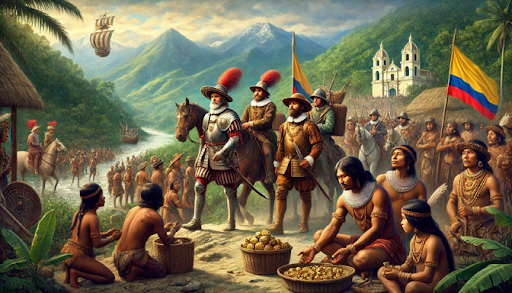Pre-Columbian Era (5th century B.C. – 16th century A.D.)
The first settlers in Colombia arrived around the 5th century B.C., crossing through the Isthmus of Panama. They belonged to the Chibcha language family, which over time divided into various groups, including the Caribs, Arawaks, and Muisca.
The Muisca, located in the central region of the country, were one of the most advanced civilizations. They engaged in agriculture, mining, weaving, and goldsmithing. Their culture gave rise to the famous myth of El Dorado, based on a ceremony in which a new chief, covered in gold dust, made an offering at Lake Guatavita.
Meanwhile, the Arawaks settled in the regions of La Guajira and Caquetá, dedicating themselves to livestock farming, agriculture, fishing, and hunting. In contrast, the Caribs were a warrior people with little significant cultural development.
Other indigenous groups such as the Quimbaya, Sinú, Tayrona, and Calima stood out for their skill in goldsmithing and pottery. It is estimated that there were around twelve indigenous cultures in Colombia before the arrival of the Spaniards.
Arrival of the Spaniards and the Myth of El Dorado (1499–1525)
In 1499, Alonso de Ojeda explored Colombian territory for the first time, landing at Cabo de la Vela. Unlike other regions of America, Christopher Columbus never set foot in Colombia.
The Spaniards were fascinated by the wealth of the indigenous peoples and began spreading the myth of El Dorado, the legend of a city made of gold. This story attracted more explorers and conquerors in search of riches.
In 1525, Rodrigo de Bastidas founded Santa Marta, the first permanent settlement on the territory and the second oldest city in South America. From there, Europeans began expanding their dominion.
Conquest and Colonization of Colombia (1533–1550)
The colonization process occurred in several stages. In 1533, Pedro de Heredia founded Cartagena, which quickly became an important commercial center.
Soon after, two expeditions led by Gonzalo Jiménez de Quesada and Sebastián de Belalcázar advanced along different routes to consolidate Spanish control:
- Quesada advanced from the coast toward the interior and in 1538 founded Santa Fe de Bogotá, which would become the capital of the New Kingdom of Granada.
- Belalcázar , coming from Ecuador, later reached Bogotá, leading to disputes over territorial control.
In 1540, Emperor Charles V incorporated the region into the Viceroyalty of Peru, granting control to Belalcázar. However, administration from Lima proved inefficient due to distance and geographical difficulties.
To improve governance, the Royal Audiencia of Santa Fe was established in 1549, a judicial body with provincial judges. However, due to lack of consensus, power was centralized in 1550 under a president with civil and military authority—a system that lasted for over 200 years.
The Viceroyalty of New Granada and Spanish Control (1717–18th century)
In 1717, Spain created the Viceroyalty of New Granada, encompassing Colombia, Panama, Ecuador, and Venezuela.
Colonizers imposed the encomienda system, which theoretically protected indigenous people but in practice subjected them to forced labor. Thanks to the efforts of friar Bartolomé de las Casas, the system was abolished in 1542 and replaced by the repartimiento system, administered by the Crown. Nonetheless, many indigenous people continued to live in conditions resembling semi-slavery.
Another method of control was evangelization, as Spain sent missionaries and clergy to convert indigenous peoples to Catholicism.
The colonization of Colombia reflected the typical pattern of Spanish conquest in America, based on the pursuit of wealth, the exploitation of indigenous peoples, and the imposition of new political and religious structures. However, the blending of indigenous, African, and European cultures gave rise to a diverse society rich in traditions.

